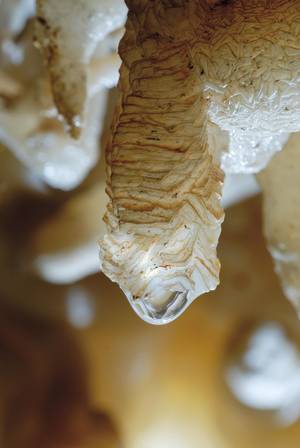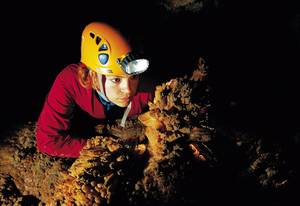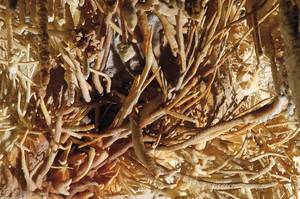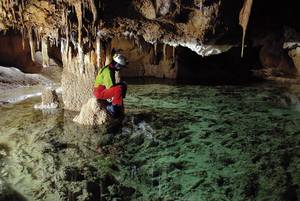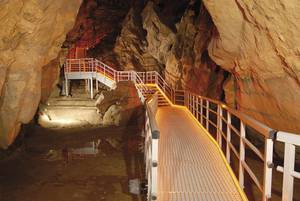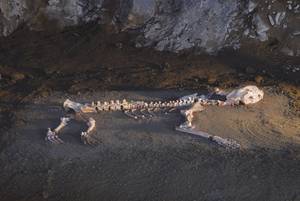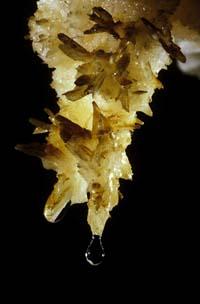Three spectacular caves of Euskal Herria: Pozalagua, Arrikrutz and Mendukilo
2012/12/01 Irazabal Tamayo, Nagore - Alfonso Antxia Espeleologi Zientzien Elkartekoa. Biologian doktorea Iturria: Elhuyar aldizkaria
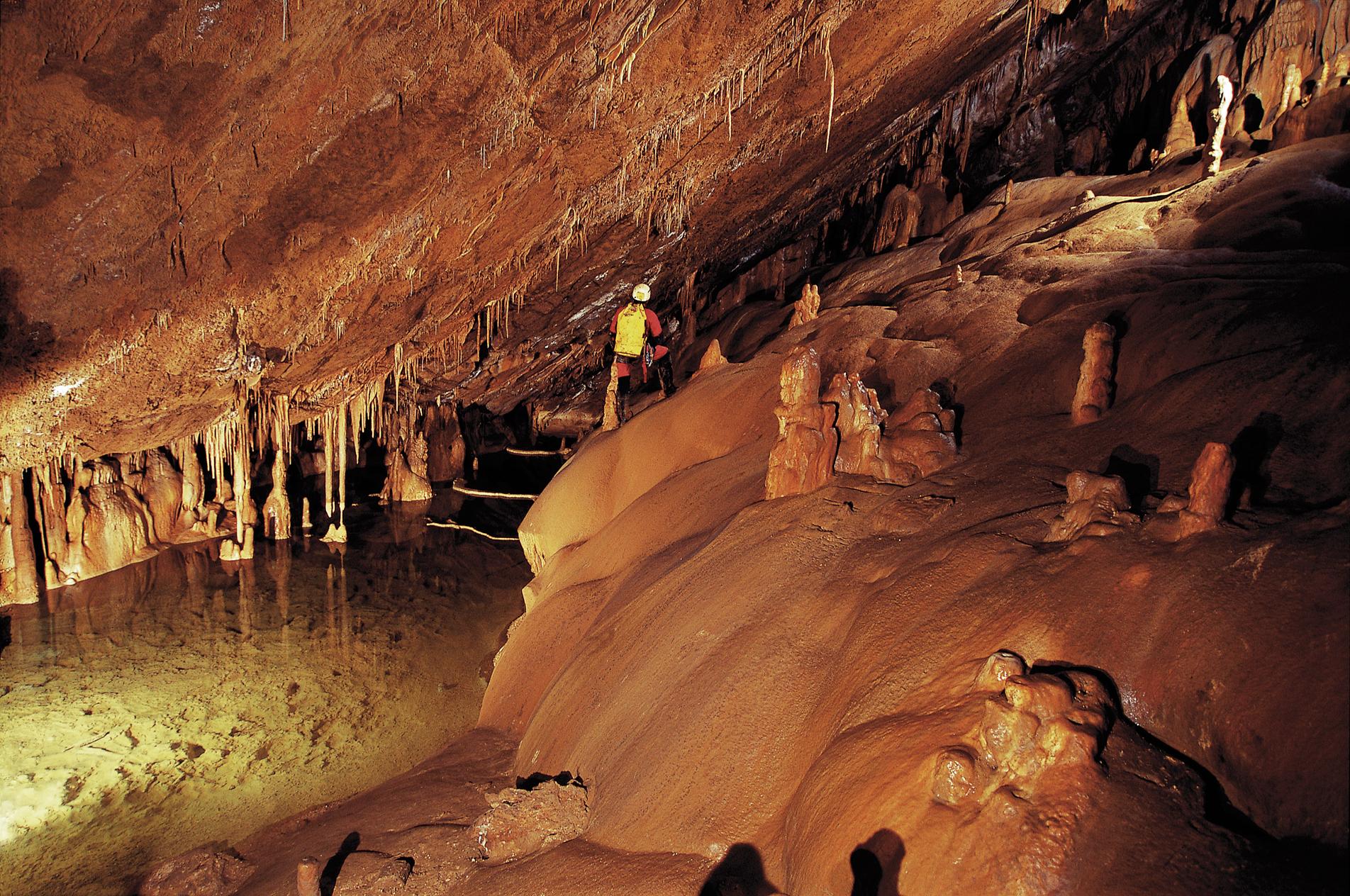
Pozalagua (cave of eccentric stalactites)
Pozalagua is located on Mount Ranero de Carranza (Bizkaia). One of the most spectacular of all Bizkaia: ceilings at a height of twenty or thirty meters, giant columns of calcite, stalactites in search of soil, "gours" or canecillos, visible stone curtains and, in general, the beauty of the cave, are the spectacular of the cave that has lasted many years.
In it, in addition, is one of the most beautiful sets in the world of eccentric stalactites, which extend to all directions instead of directing them towards the ground.
For centuries and during all the silence, water, calcium carbonate and magic have created a winding jungle of eccentric stalactites. Eccentric stalactites, although it is a known phenomenon, are still very little known and always considered exotic and unusual. This cave, even if only for the number of eccentric stalactites it possesses, is worth visiting. Researchers do not know how these mineral deposits were converted, but they know that nature has created these structures for thousands of years. Someone once said looking at the eccentrics of Pozalagua: "This is a winter palace, it seems to be Versailles." Nature has used all its resources to create such a unique treasure in the bowels of the mountain. From then on, the cave houses a room called Versailles.
Pozalagua is part of the Natural Park of Armañón. It includes extensive autochthonous forests such as oak, oak and beech forests, as well as mixed hardwood forests in valleys and hillsides. Therefore, visitors can also perform nice routes around.
Mendukilo (cave of the lakes)
The cave of Mendukilo is located in the valley of Larraun (Navarre), in communal lands of the Council of Astitz, in the foothills of the mountain of Aralar at 750 m of height. Its use by the shepherds is very old, since it is suitable for use as a mountain refuge, due to two characteristics: the entrance mouth, facing north, and the first spacious room, accessible and well lit by natural light. The name of the cave has its origin in it, that is, it was the stable of Mount Mendukilo. The small archaeological site found in the entrance hall (Artzainzulo) shows that the shepherds of the area during the Iron Age (800-300 BC) They also used it. It is currently adapted to welcome tourists and schoolchildren. It has outdoor parking, host house and a small botanical tour.
The aim of the cave is to show the wonders of the subsoil so that the visitor becomes aware of the importance of caring for and protecting these things. The habilitation of the cave has had a double objective: to prime the cave and minimize the impact. To respond to the first objective, two of the six rooms of the cave have not been conditioned for the public, since the accesses to these rooms are very narrow and so that visitors can access it is necessary to drill much. In addition, the fauna and quality of the cave abandoned in the existing ones has been respected. On the other hand, to minimize the impact of the habilitation, removable infrastructures have been installed and currently you can visit the halls Artzainzulo, Laminosin and Herensuge.
Throughout the year, guided tours are carried out and the script is based on the principles of environmental education. In addition, throughout the school year, programs aimed at schoolchildren based on environmental education are carried out. The aim of these programs is to awaken sensitivity and awareness, since knowledge is the basis of respect. The teaching units are adapted to the school curriculum of each course and aim to be a practical component of the work in the theoretical classes.
As for the exterior, the abundance of megalithic monuments (the first, built more than 4,000 years ago) throughout the mountain range, indicates that it has been present since the pasture prehistory. The pastures that demand the cattle and the way of life of the shepherds, that is, the human influence, have shaped to a large extent the current aspect of the mountains, whose ecosystem is the result of long years of coexistence between the grazing and the wildlife. Without forests we can see perfectly some of the outer formations of karst: dolinas, lapiaces, cliffs...
The Mendukilo Project has gone from being a mountain stable to being an ecotourism equipment, an underground laboratory and an environmental education room. Following the philosophy of the first shepherds who used the cave, a responsible training focused on management oriented towards ecotourism is proposed.
Its objective is to recover and maintain the natural space in which ecotourism is developed. That is, it aims to be a useful tool for the recovery of natural space, which ensures the enjoyment of the coming generations, since the only natural space profitable is that which lasts from generation to generation. In this way, in addition to developing in a natural space, it must be developed both by the environment and by the environment. Economic benefits will result in the benefit of the local population. But it also offers visitors the possibility of enjoying a healthy leisure and expanding knowledge about nature.
In this sense, ecotourism and well-oriented and planned rural tourism can be a balanced development of the valley and its surroundings. With the aim of capturing and promoting tourism resources in the area, the Plazaola Tourism Consortium was established in 1994. For this reason, the following complementary actions have been launched:
- Plazaola passport. The proposal promoted by the Tourism Consortium has involved numerous rural houses, restaurants, activity companies and tourism resources. In this initiative, a sealed passport generates different discounts in participating establishments.
- Subsoil Without Borders. 6 tourist caves twinned (Mendukilo, Arrikrutz, Pozalagua, Ikaburu, Sara and Zugarramurdi) to facilitate access to the underground world visitor and reward the visit. In this initiative, a promotional brochure has been created with all the information about each of the twinned caves. This brochure is sealed when you visit a cave and entitles you to a discount of the individual rate when you visit another cave. With all the sealed brochure is collected a gift in the last cave visited.
Arrikrutz-Oñati caves (mythology and legends)
Inside Gipuzkoa, the landscape of Oñati has interesting elements of great quality. On the slopes of Mount Aizkorri, near the Sanctuary of Arantzazu, there are spectacular limestones, and on the underground, along 14 kilometers that houses the complex and spectacular karst systems of Salinas de Arrikrutz, phenomena and complex speleological spaces like the cavity of the cave of Arrikrutz.
The underground streams and galleries filled with enormous stalactites are a sign of their geological composition and richness.
The tourism project aims to increase the value of natural and cultural heritage. Arrikrutz is one of the pioneers of Euskadi in speleological, archaeological and paleontological studies. In the first works archaeological remains were discovered as the complete skeleton of a rock lion, first discovery of this type in the State. In addition, it has skeletal remains and skulls of panthers and a spectacular deposit of bears.
As for mythology, it should be noted that hundreds of years ago the inhabitants of Oñati, Alto Deba and Alava went to the cave of Sandaili on pilgrimage to ask for rain for the solos. On the other hand, sterile women bathed in the waters of Sandaili to be fertile. In this way the customs created thousands of years before -- at the time of the Gentiles were maintained. Taking into account all these considerations, the Council of Oñati, unanimously decided to improve and complete its natural offer, preparing the cave of Oñati-Arrikrutz for the reception of visitors.
The system of travel through the interior of the cave allows to approach from a pedagogical point of view and in a totally interesting way topics such as the chiseling of the cave by water and hydrology, the creation of the mineral universe, the archaeological and paleontological findings of Arrikrutz, the Sandailian mythology or the importance of Arrikrutz in the history of speleology.
Linguistic advisor: Agurtzane Urrutia.
Offer on offer Offer
Iñaki
You go away, you come, and you leave rings in my imagination (G. Belli)
Asierri
Justice is like snakes, they only bite barefoot (E. Galeano)
Asier died on December 1, 2008, in a work accident that occurred in the Southern Variant of Bilbao (Supersur), due to the failure to comply with safety measures at work, as resolved on Bilbao's 9th. Judgment nº 131 of 18 March 2011 of the Social Tribunal. However, we were annulled by the criminal procedure. (asierirazabal.wordpress.com).
Bibliography Bibliography Bibliography

Gai honi buruzko eduki gehiago
Elhuyarrek garatutako teknologia




